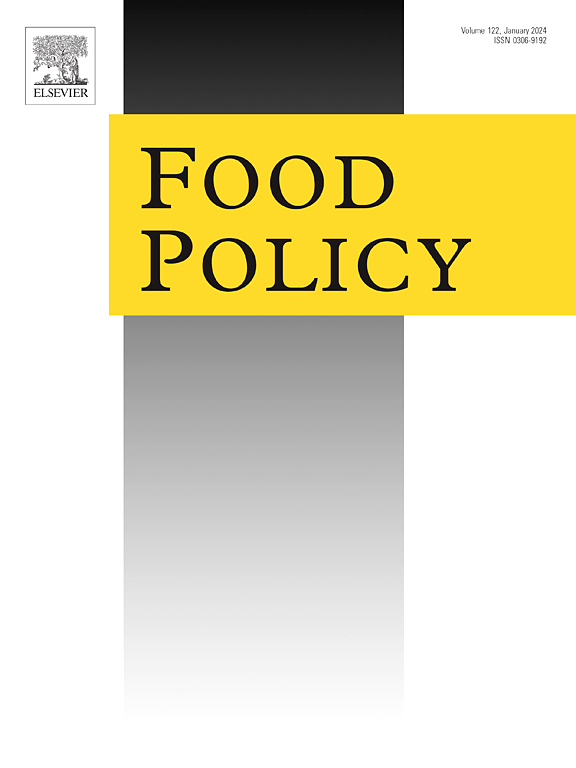Joint agricultural input use and food security: evidence from Tanzania
IF 6
1区 经济学
Q1 AGRICULTURAL ECONOMICS & POLICY
引用次数: 0
Abstract
The joint use of hybrid seeds and inorganic fertilizer, at appropriate levels, is necessary to boost cereal productivity by supplementing soil nutrients in Sub-Saharan Africa (SSA). While these two inputs are ‘paired’ together for integrated soil nutrient management, empirical studies often focus on the use of one of these inputs as a dichotomous choice. This study models the joint use of hybrid seeds and inorganic fertilizer and its impact on different dimensions of food security. The analysis is based on a sample of 1,653 unique maize growing households (3,306 observations) over 4 rounds of the Living Standards Measurements Study – Integrated Surveys of Agriculture (LSMS-ISA) from Tanzania, spanning 10 years between 2010/11 to 2020/21. The Multinomial Endogenous Switching Regression with Correlated Random Effects (MESR + CRE) models self-selection into four potential regimes of input use. The results show that the Average Treatment on the Treated (ATT) of joint inputs use increased maize productivity by 17–39 % and improved food utilization with more diverse diets, by 1.9 food groups in some cases. Further, Average Treatment on the Untreated (ATU) estimates show that farms that do not use both inputs could improve their food security. However, the improvements are restricted by low profitability or even losses under joint input use. Sub-sample analysis in this study shows that the treatment effects are quite heterogenous. Households with more exposure to heat and moisture stress and limited access to services face lower profitability on adoption, limiting the impact on food security outcomes. The findings from this study suggest more targeted approaches to incentivize joint input use and diversification of strategies since agricultural input-based interventions may have limited impacts for households exposed to adverse weather and experiencing severe food insecurity.
联合农业投入物使用与粮食安全:来自坦桑尼亚的证据
在撒哈拉以南非洲(SSA),必须在适当水平上联合使用杂交种子和无机肥料,通过补充土壤养分来提高谷物生产力。虽然这两种投入“配对”在一起用于综合土壤养分管理,但实证研究往往侧重于将其中一种投入作为一种二分选择。本研究模拟了杂交种子与无机肥料的联合使用及其对粮食安全不同维度的影响。该分析基于坦桑尼亚生活水平测量研究-农业综合调查(lsm - isa)的4轮抽样(3306个观察值),时间跨度为2010/11至2020/21年,共10年。基于相关随机效应的多项内生转换回归(MESR + CRE)模型对四种潜在的投入使用机制进行了自我选择。结果表明,联合投入品使用的平均处理(ATT)使玉米产量提高了17 - 39%,并通过更多样化的饮食提高了粮食利用率,在某些情况下提高了1.9个食物组。此外,未经处理的平均处理量(ATU)估计表明,不使用这两种投入物的农场可以改善其粮食安全。然而,在联合投入使用的情况下,这种改进受到低利润率甚至亏损的限制。本研究的子样本分析表明,处理效果具有较大的异质性。受湿热压力影响更大且获得服务的机会有限的家庭在采用方面的盈利能力较低,从而限制了对粮食安全结果的影响。本研究的结果建议采取更有针对性的方法来激励投入的联合使用和战略的多样化,因为基于农业投入的干预措施对面临恶劣天气和严重粮食不安全的家庭的影响可能有限。
本文章由计算机程序翻译,如有差异,请以英文原文为准。
求助全文
约1分钟内获得全文
求助全文
来源期刊

Food Policy
管理科学-农业经济与政策
CiteScore
11.40
自引率
4.60%
发文量
128
审稿时长
62 days
期刊介绍:
Food Policy is a multidisciplinary journal publishing original research and novel evidence on issues in the formulation, implementation, and evaluation of policies for the food sector in developing, transition, and advanced economies.
Our main focus is on the economic and social aspect of food policy, and we prioritize empirical studies informing international food policy debates. Provided that articles make a clear and explicit contribution to food policy debates of international interest, we consider papers from any of the social sciences. Papers from other disciplines (e.g., law) will be considered only if they provide a key policy contribution, and are written in a style which is accessible to a social science readership.
 求助内容:
求助内容: 应助结果提醒方式:
应助结果提醒方式:


